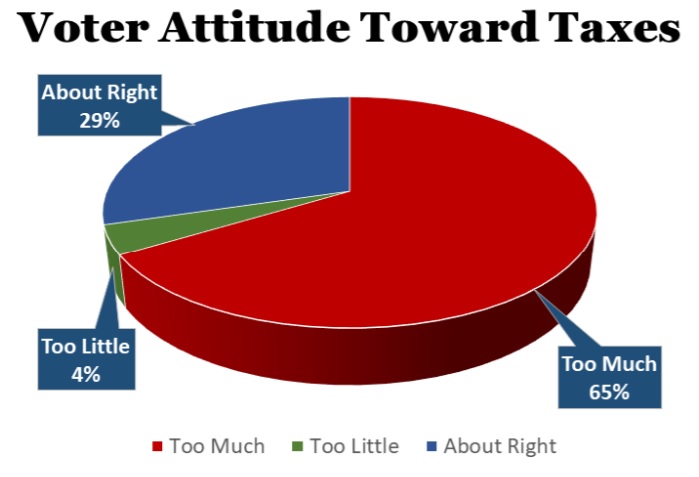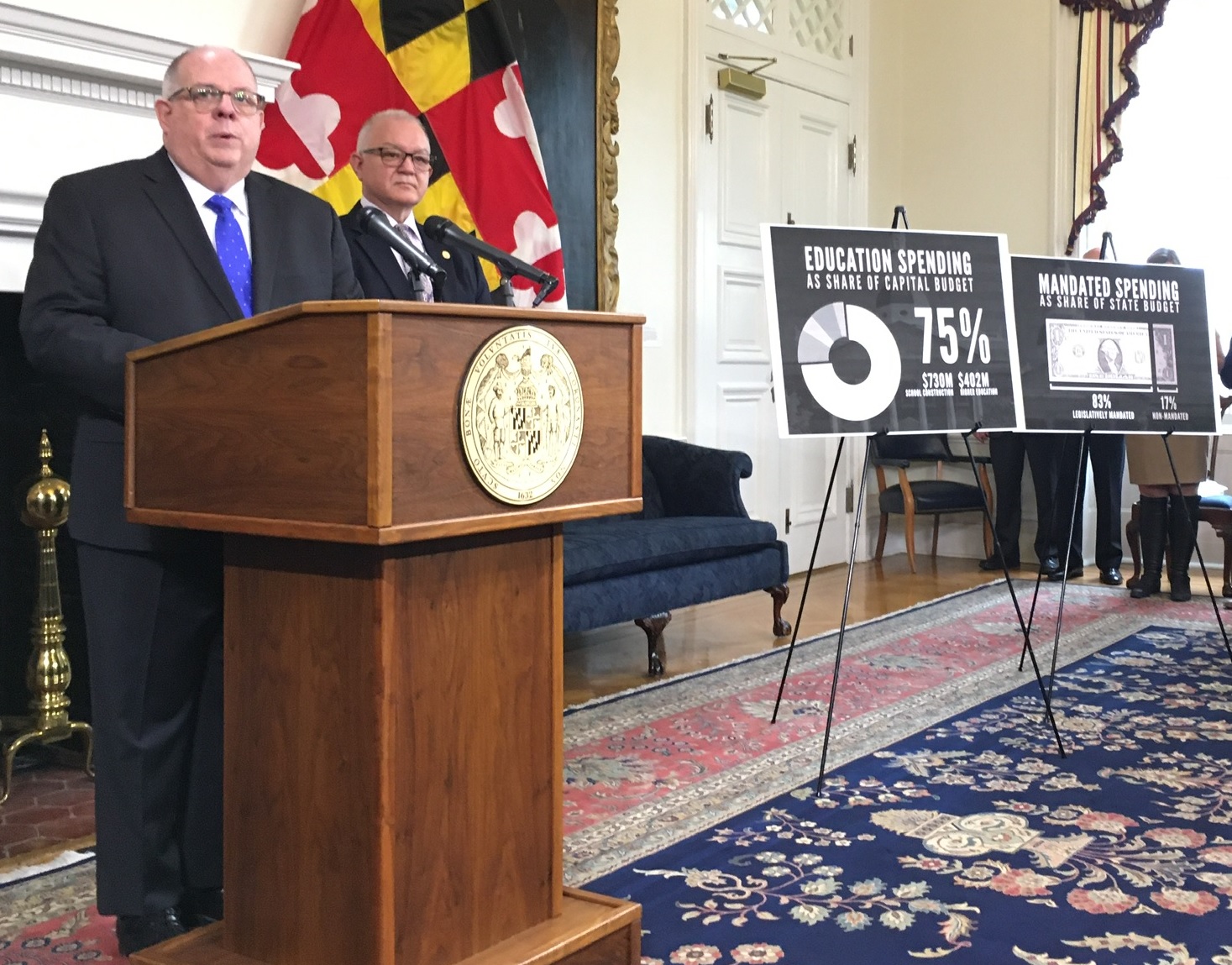A version of this column appears in the February issue of The Business Monthly newspaper, serving Howard and Anne Arundel counties. It has been updated to reflect last week’s hearing.
By Len Lazarick
[email protected]
Record funding for education, record funding for health care, record funding for mental health and substance abuse treatment in a record state budget just shy of $48 billion. And no new taxes.
Gov. Larry Hogan takes credit for record after record in spending on schools and sick people. And then he lambasts the spending mandates in state law that control 83% of the budget and drive the record spending – though in some cases Hogan has added money to the mandated spending.
In many cases, he takes credit for what he is forced to do. But given the mandates, it is no small feat to balance a state budget where expenses are rising faster than revenues, and to do it with no new taxes.
Democrats this session are pushing for one of the biggest increases in spending mandates to fund the sweeping school reforms of the Kirwan Commission on education. These include universal pre-Kindergarten, enhanced services for schools in impoverished areas, better career, and technical education, and higher pay for teachers.
Hogan has agreed to fund the start of these mandates – but balks at any further changes that will balloon the budget and require higher taxes.
The new Democratic Senate president and House speaker – the first change in legislative leadership in decades – have recognized that Marylanders feel they are already overtaxed. This strong voter sentiment helped Republican Hogan get reelected twice in a Democratic state.
Senate President Bill Ferguson and House Speaker Adrienne Jones both have ruled out increasing the sales, income or property taxes – this year at least.
Taxed too much, voters tell pollster
A new poll commissioned by the House Republican Caucus puts hard data behind the opposition to any tax hikes. The survey by longtime Maryland pollster Patrick Gonzales found that voters in every subgroup thought they paid too much in taxes. That included 60% of Democrats, 78% of Republicans, 72% of women and 73% of African Americans. (The poll question did not distinguish between federal, state and local taxes. The poll of 838 likely voters has a margin of error of plus or minus 3.5%)

Graphic by Gonzales Research
On the flip side, the poll then asked: “How much would you be willing to pay every year in new taxes to increase public school funding in Maryland?” Statewide, there was a slight majority (52%) who opposed any new taxes, but even among the 60% of Democrats who said they would be willing to pay more for schools – the group most amenable to tax hikes — 25% of Democrats said they would only be willing to pay $250 more, while 19% said they would be willing to pay $500 to $1,000 more. This is not enough to fund the package long-term.
When fully implemented in 10 years, the Kirwan recommendations are expected to cost $4 billion more a year than is already spent on public schools which is now about $15 billion statewide, $7.3 billion coming from the state. The state would pay about $2.8 billion more in the 10th year, and the counties $1.2 billion more. Of course, they are taking money from the same taxpayers.
Scrambling for other sources
That’s why legislators are scrambling for other sources of taxes that do not hit Marylanders in their personal wallets.
A referendum to approve sports betting has been introduced again. Based on the experience in Nevada, legislative analysts estimate that sports betting might only bring in $35 million, chump change for the huge budget. Legalizing recreational marijuana has been put off the table this year, but medical marijuana brought in $10 million in taxes last year.
Ferguson and his predecessor, Senate President Emeritus Mike Miller, are proposing a novel idea to tax digital advertising (SB2), primarily the kind you find from Google and Facebook. The bill expressly targets companies that bring in more than $100 million in global ad revenue. The biggest companies with billions in total sales would pay up to 10% tax based on where the ads are appearing on a device registered in Maryland.
Google and Facebook have faced these issues in other states, but no such tax has passed. They would certainly be expected to put up a vigorous fight, despite the high-powered sponsors. Both Google and Facebook have the same lobbying firm in Annapolis, mainly to keep an eye on anything that might hurt them.
A hearing last week drew the expected a long list of opponents, from Comcast and advertising trade groups to the Motion Picture Industry and Maryland-Delaware-D.C. Press Association. (Disclosure: I am treasurer of MDDC and sit on its board.)
The opponents cited legal, constitutional and technical problems with the bill, problems also cited by the legislature’s own staff. There’s federal law that may prevent it, there are U.S. Supreme Court and Maryland court decisions that say it would be a violation of the first amendment, and there are all sorts of technical issues that might make it difficult to track. Making the tech giants pay more than Maryland advertisers may also violate the commerce clause of the U.S. Constitution.
A group of Montgomery County legislators are proposing a carbon tax on energy use and polluters, with part of the proceeds going to Kirwan funding. The bill also includes a tax on gas guzzling autos and SUVs, however that might be defined.
Sen. Paul Pinsky, D-Prince George’s, and other progressive groups have proposed that old chestnut, combined reporting of the corporate income tax. This tries to target out-of-state corporations that supposedly do not pay their fair share in state taxes, such as Walmart. SEIU, the service employees union, and a group of progressive legislators has also proposed an increase in the state personal income tax for earners making over $1 million but that is a nonstarter for the presiding officers.
Taxing services
As the economy has changed to emphasize services rather than goods, especially online, this is an area of opportunity for tax-writing legislators, hence the digital advertising tax. But attempts to tax services have failed before.
The most glaring example occurred in 2007 when the Maryland legislature passed a package of tax increases – including the current 6% sales tax — that taxed computer services to the tune of $200 million a year. The computer industry was taken by surprise but pushed back so strongly that the legislature repealed it before it could take effect.
Lawmakers then added a temporary surcharge on millionaires, which pushed some of them to Florida and other states that have no income tax.
The hard part is devising a service tax that captures some of that huge market without hurting the local economy or forcing companies to leave the state, as a tax on accounting or legal services might do.
The challenge won’t keep legislators from trying, despite Hogan’s opposition to any new taxes.




Without a doubt people are in favor of improving the Maryland education system to be globally competitive, albeit, WITHIN A FAIR AND REASONABLE FISCALLY SOUND PLAN AND BUDGET!
Respect is expressed for the effort the Kirwan Commission members put into this study and their recommendations, TO A POINT!
As we all know, the Kirwan Commission has estimated the cost to implement their recommendations to be $4,000,000,000.00 per year, every year, cumulatively. To illustrate the potential effect of this HUGE NUMBER on Marylanders, let’s spread the cost of Kirwan evenly over all Maryland households.
Per Census, there are approximately 2,200,000 Maryland households. Simple math, that amounts to an estimated $1,800.00 additional expense per household, per year, every year, cumulatively, for 10
years; $18,000.00.
Although this funding plan example would never be implemented, it is an eye opening calculation. And, as we know, any tax or fee imposed by the General Assembly to fund Kirwan WILL trickle its way down to the BASIC SOURCE FOR ALL MONEY for the State, and for that matter, all Counties, down to all Marylanders.
We have a 10% poverty rate in Maryland, with many households living pay check-to-pay check. Just how will Maryland households afford the cost of a Kirwan? Real Estate Taxes are part of the budget and financial plan for affording a home; we are trying to entice families to stay-in Maryland.
Question: who among us would decide to fully upgrade our home, with: new roof/siding; new cabinets, countertops, sinks, faucets for kitchen and bathroom[s]; all new kitchen appliances – refrig, dish washer, stove, oven; plus, maybe, a new refrig in basement or garage; fresh coat of interior paint; all new ceiling light fixtures; a new heating and a/c system; construction of a room addition and/or patio; and a new driveway, without first and foremost establishing how much we could afford and how we were going to pay for it? NO ONE!
And yet, that is exactly what the Kirwan Commission did; which, for many of us, is fiscally irresponsible.
Being prudent, practical and sensible, we take a look at what our family can afford, figure out how we are going to pay for it, and plan accordingly.
The Kirwan Commission didn’t do that.
Yes, yes, yes! By all means allow the educational industry and their labor union racketeers to drive Maryland into bankruptcy. With a little luck they’ll find themselves in the same position like the State of Kalifornia which will soon be looking for a federal bail out.
The media pushes this type of irresponsible behavior because their overarching goal is globalism. They had been steadily convincing the federal legislators to buy into their diabolic plan, but then Trump came along and threw a monkey wrench into their works. They’re now focusing more of their attention on the states. And since the RINO Hogan (all-hat and no-cattle Hogan) is no Trump, Maryland is easy pickings. Truth is, Hogan wouldn’t make a pimple on Trump’s behind.
Consequently, the results of the media’s plan is now becoming painful obvious––wise Marylanders are leaving the Free State in droves. As a former-Marylander who woke up long ago, the only thing I can say is let’s hope the last one who leaves Maryland turns out the lights.
The “education racket” has had more than enough funding over the past 34 years that I have been here and has nothing to show for it…
Buildings in benign neglect, lack of school supplies, etc.
And what happened to the tax revenues from the casinos that was to go to the schools ( the reason why the casinos were allowed in Maryland and the State Constitution was amended to allow it ).?
Where did that money go ?
The “education rackets” at the State and County levels are very much top-heavy with “administrators” and wasteful curricula, tricks, and “gimmicks”…
Maybe those legislators should not be paid and the State budget be scrutinized for tax cutting and elimination… Starting with the State Department of Education !